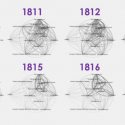From their earliest incarnations in the seventeenth-century, through their Georgian expansion into provincial and colonial markets and culminating in their late-Victorian transformation into New Journalism, British newspapers have relied upon scissors-and-paste journalism to meet consumer demands for the latest political intelligence and diverting content. However, mass digitisation of these periodicals, in both photographic and machine-readable form, offers historians a new opportunity to rediscover the mechanics of nineteenth-century reprinting. By undertaking multi-modal and multi-scale analyses of digitised periodicals, we can begin to reconstruct the precise journeys these texts took from their first appearance to their multiple ends. Moreover, by repurposing individual ‘boutique’ research outputs within large-scale textual analyses, we can greatly enhance the resolution of our computer-aided conclusions and bridge the gaps between commercial, state and private databases.
This paper will explore the possibilities of large-scale reprint identification, using out-of-the-box and project-specific software, within and across digitised collections. Second, it will demonstrate the means by which reprint directionality and branching can be achieved and the relative precision of manual and computer-aided techniques. Finally, it will explore the nature of multi-scale analysis and how we might best reintegrate ‘boutique’ periodical research into large-scale text-mining projects.
Access the full post, video, and slides here.

